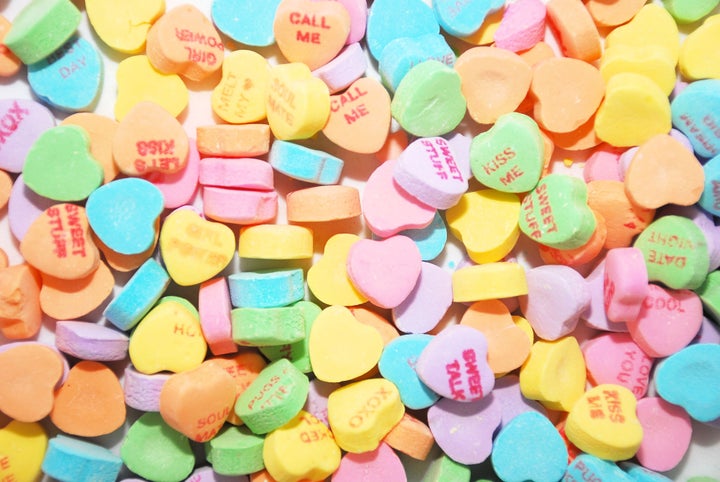
Conversation hearts, Necco hearts, candy hearts, Sweethearts ― people use many different names to describe those tiny chunks of candy sporting short messages that are ubiquitous around Valentine’s Day.
The candy is iconic, and pretty much synonymous with the most romantic day of the year. This month, Kim Kardashian is celebrating the release of her three Valentine’s Day-themed Kimoji Hearts Fragrance perfumes by sending them to friends and influencers (and, apparently, “haters”) inside large conversation heart cases made of chocolate.
But when it comes to actually eating real conversation hearts... well, let’s just say it’s a divisive topic.
Frankly, the debate is up there with candy corn and marshmallow Peeps.
Either you can’t get enough of them, or you see no reason why anyone would eat candy that seems like a second cousin to sidewalk chalk.
But what are they even made of? And where did they come from? In honor of Valentine’s Day, we took a look at the history and process behind conversation hearts.
FIRST KISS: The history of the hearts
The story of conversation hearts begins in 1847, when a Boston pharmacist named Oliver Chase invented a machine that would make it easier to produce lozenges.
At the time, apothecary lozenges (basically medicine mixed with sugar paste) were in high demand as a popular remedy for sore throats and other ailments. But making them was a labor-intensive process that involved pulverization with a mortar and pestle, kneading dough, rolling it out and cutting it into small discs.
Oliver simplified the process with his lozenge cutter, often considered America’s first candy-making machine. The pharmacist then shifted his focus from medicinal lozenges to straight candy, and founded Chase and Company, which later became the New England Confectionery Company, or Necco.
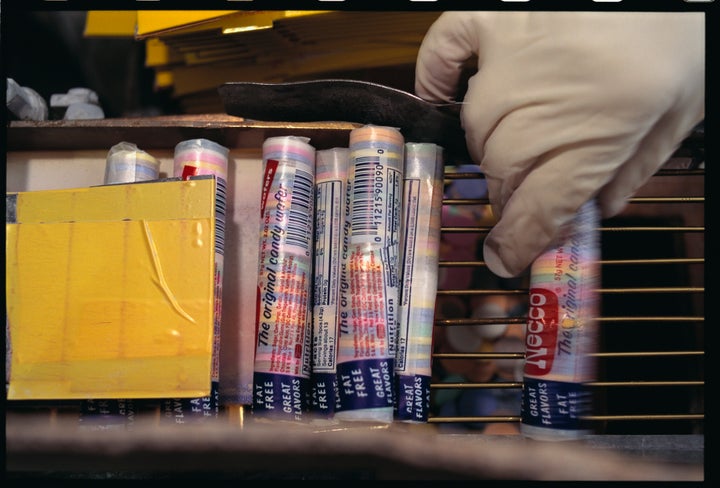
The candy lozenges became what we know today as Necco wafers.
In 1866, Daniel Chase, brother of Oliver, devised a way to press words onto the candy lozenges, using a felt roller pad moistened with vegetable coloring (usually red).
There are a few different theories about the inspiration behind these special printed lozenges.
One unverified legend claims that Union soldiers in the Civil War carried around Necco wafers, then known as “hub wafers,” and the practice of sending romantic letters to soldiers sparked the idea for conversation hearts.
Others suggest that Daniel was inspired by the growing popularity of Valentine’s Day cards, which Massachusetts resident Esther Howland started selling in the mid-1800s.
What seems like a more likely explanation is that Daniel drew his inspiration from cockles, a popular candy shaped like a scallop shell that contained a “motto” printed on thin, rolled-up paper. He decided to devise a way to print the messages directly onto candy.
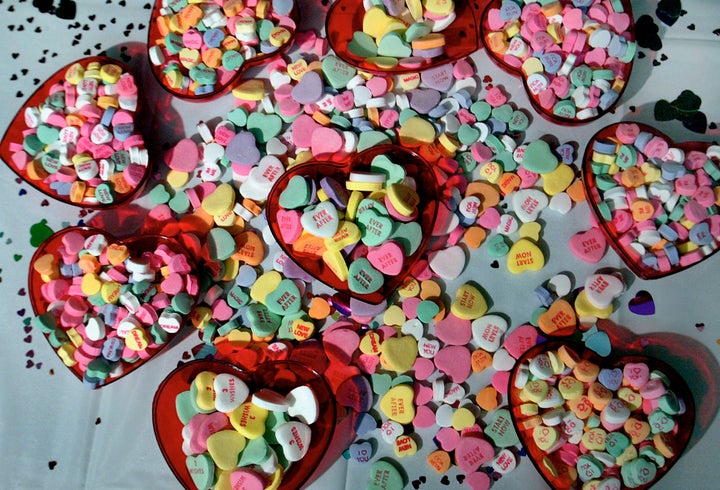
Daniel’s “conversation candies” or “motto lozenges” were not heart-shaped until 1902. Around that time, the candy, previously sold as simple discs, also started appearing in fun shapes like baseballs, horseshoes and watches.
Conversation hearts were a big success, and over the next century, other small candy companies started offering similar products. With the acquisition of Stark Candy Company in 1990, Necco says it became “the leading manufacturer of conversation hearts.”
Today, the company claims to produce about 100,000 pounds of Sweethearts every day from mid-February through January. It produces approximately 8 billion candy hearts each year.
UR SWEET: What they’re made of
Necco offers classic Sweethearts, as well as sugar-free, chocolate, “color your own” and “dazzled” varieties. The company website describes how the classic candy hearts are made.
Manufacturers combine sugar, corn syrup, cornstarch, flavors, gums and colors into a mixing machine to create a dough, which then goes into a machine that presses it flat, stamps it with sayings and cuts it into hearts. After 30 minutes in a “drying tunnel,” the six different heart flavors are mixed together and packaged.
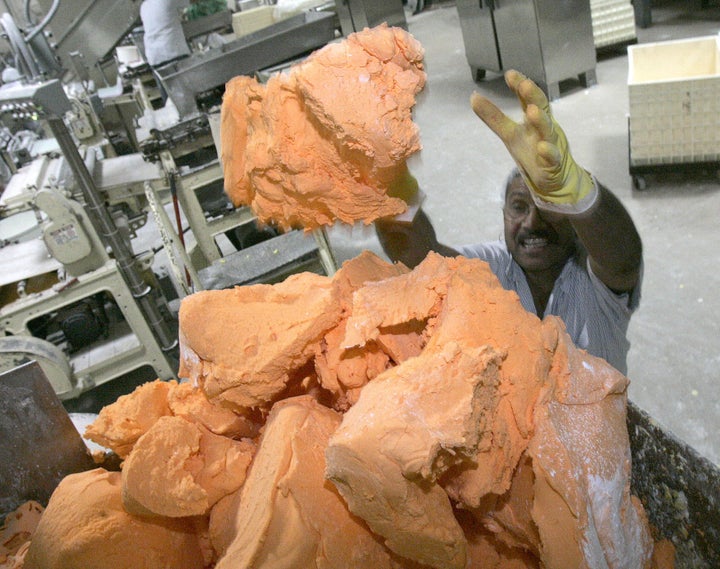
According to the ingredient list on the box, Sweethearts contain sugar, corn syrup, dextrose, glycerine, artificial and natural flavors, gelatin, vegetable gums (tragacanth, xanthan and arabic), citric acid, and artificial colors (red 3, yellow 5, yellow 6, red 40, blue 1).
So, no, they’re not made of chalk.
TEXT ME: The sayings
The phrases on conversation hearts have an interesting history. Daniel Chase’s original printed lozenges were a bit larger, and sported longer phrases like “HOW LONG SHALL I HAVE TO WAIT? PLEASE BE CONSIDERATE” and “WHY IS A STYLISH GIRL LIKE YOU A THRIFTY HOUSEKEEPER?” (The answer, on the other side: “BECAUSE SHE MAKES A BIG BUSTLE ABOUT A LITTLE WAIST.”)
There were also a number of wedding-themed sayings, some more encouraging than others: “MARRIED IN WHITE, YOU HAVE CHOSEN RIGHT”; “MARRIED IN SATIN, LOVE WILL NOT BE LASTING”; “MARRIED IN PINK, HE WILL TAKE TO DRINK.”
Over time, these were shortened to the more familiar “BE MINE” and “KISS ME” fare.
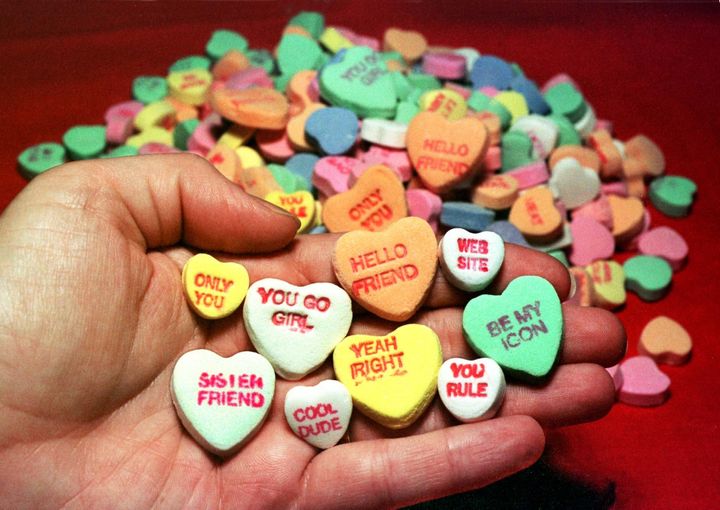
Necco has added and dropped phrases from its Sweethearts line to keep up with the way people speak. (See: “FAX ME,” “GROOVY” and “YOU ARE GAY.”)
The company has also partnered with the “Twilight” movie franchise to offer hearts with sayings like “BITE ME,” “LIVE 4 EVER” and “FORKS.”
For Necco’s 150th anniversary in 1997, the candy maker brought back a message from the early 20th century: “THE ONE I LOVE.” Today, the company offers Spanish-language Sweethearts with phrases like “TE AMO.”
Your own feelings about conversation hearts, of course, may vary. But at least now you’ll have a bit more context when you and a fellow candy partisan are arguing whether these hearts are “SO FINE” or “NO WAY.”